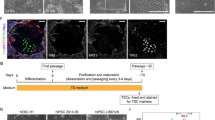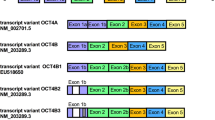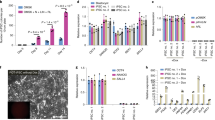Abstract
Human amniotic fluid stem cells (hAFSCs) are a very promising new type of fetal stem cells with numerous applications for basic science and cell-based therapies. They harbor a high differentiation potential and a low risk for tumor development, can be grown in large quantities and do not raise the ethical concerns associated with embryonic stem cells. RNA interference (RNAi) is a powerful technology to explain specific gene functions and has important implications for the clinical usage of tissue engineering. We provide a straightforward, 72-h-long protocol for siRNA-mediated gene silencing in hAFSCs. The lipid-based forward transfection protocol described in this article is the first RNAi approach for prolonged gene knockdown in hAFSCs. This protocol allows efficient, functional and reproducible gene knockdown in human stem cells over a prolonged period of time (∼2 weeks). We also show the successful use of this protocol in primary nontransformed nonimmortalized fibroblasts, cervical adenocarcinoma cells, transformed embryonic kidney cells, immortalized endometrial stromal cells and acute monocytic leukemia cells, suggesting a wide spectrum of applications in various cell types.
This is a preview of subscription content, access via your institution
Access options
Subscribe to this journal
Receive 12 print issues and online access
$259.00 per year
only $21.58 per issue
Buy this article
- Purchase on Springer Link
- Instant access to full article PDF
Prices may be subject to local taxes which are calculated during checkout


Similar content being viewed by others
References
Prusa, A.R., Marton, E., Rosner, M., Bernaschek, G. & Hengstschläger, M. Oct4 expressing cells in human amniotic fluid: a new source for stem cell research? Hum. Reprod. 18, 1489–1493 (2003).
De Coppi, P. et al. Isolation of amniotic stem cell lines with potential for therapy. Nat. Biotech. 25, 100–106 (2007).
Valli, A. et al. Embryoid body formation of human amniotic fluid stem cells depends on mTOR. Oncogene 29, 966–977 (2010).
Siegel, N., Rosner, M., Hanneder, M., Valli, A. & Hengstschläger, M. Stem cells in amniotic fluid as new tools to study human genetic diseases. Stem. Cell Rev. 3, 256–264 (2007).
Perin, L., Sedrakyan, S., Da Sacco, S. & De Filippo, R. Characterization of human amniotic fluid stem cells and their pluripotential capability. Methods Cell Biol. 86, 85–99 (2008).
Cananzi, M., Atala, A. & DeCoppi, P. Stem cells derived from amniotic fluid: new potentials in regenerative medicine. Reprod. Biomed. Online 18, 17–27 (2009).
Pappa, K. & Anagnou, N.P. Novel sources of fetal stem cells: where do they fit on the developmental continuum? Regen. Med. 4, 423–433 (2009).
Whitehead, K.A., Langer, R. & Anderson, D.G. Knocking down barriers: advances in siRNA delivery. Nat. Rev. 8, 129–138 (2009).
Schaniel, C. et al. Delivery of short hairpin RNAs—triggers of gene silencing—into mouse embryonic stem cells. Nat. Methods 3, 397–400 (2006).
Hough, S.R., Clements, I., Welch, P.J. & Wiederholt, K.A. Differentiation of mouse embryonic stem cells after RNA interference-mediated silencing of Oct4 and Nanog. Stem Cells 24, 1467–1475 (2006).
Karlmark, K.R. et al. Activation of ectopic Oct4 and Rex-1 promoters in human amniotic fluid cells. Int. J. Mol. Med. 16, 987–992 (2005).
Grisafi, D. et al. High transduction efficiency of human amniotic fluid stem cells mediated by adenovirus vectors. Stem Cell Dev. 17, 953–962 (2008).
Ye, L. et al. Induced pluripotent stem cells offer new approach to therapy in thalassemia and sickle cell anemia and option in prenatal diagnosis in genetic diseases. Proc. Natl Acad. Sci. USA 106, 9826–9830 (2009).
Li, C. et al. Pluripotency can be rapidly and efficiently induced in human amniotic fluid-derived cells. Hum. Mol. Genet. 18, 4340–4349 (2009).
Cheng, F.C. et al. Enhancement of regeneration with glia cell line-derived neurotrophic factor-transduced human amniotic fluid mesenchymal stem cells after sciatic nerve crush injury. J. Neurosurg 112, 868–879 (2010).
Rosner, M. et al. CDKs as therapeutic targets for the human genetic disease tuberous sclerosis? Eur. J. Clin. Invest. 39, 1033–1035 (2009).
Chu, I.M., Hengst, L. & Slingerland, J.M. The Cdk inhibitor p27 in human cancer: prognostic potential and relevance to anticancer therapy. Nat. Rev. Cancer 8, 253–267 (2008).
Rosner, M. et al. The mTOR pathway and its role in human genetic diseases. Mutat. Res. 659, 284–292 (2008).
Wang, X. & Proud, C.G. Nutrient control of TORC1, a cell-cycle regulator. Trends Cell Biol. 19, 260–267 (2009).
Rosner, M., Fuchs, C., Siegel, N., Valli, A. & Hengstschläger, M. Functional interaction of mTOR complexes in regulating mammalian cell size and cell cycle. Hum. Mol. Genet. 18, 3298–3310 (2009).
Dunlop, E.A. & Tee, A. Mammalian target of rapamycin complex 1: signalling inputs, substrates and feedback mechanisms. Cell Signal. 21, 827–835 (2008).
Karni, R. et al. The gene encoding the splicing factor SF2/ASF is a proto-oncogene. Nat. Struct. Mol. Biol. 14, 185–193 (2007).
Li, X. & Manley, J.L. Alternative splicing and control of apoptotic DNA fragmentation. Cell Cycle 5, 1286–1288 (2006).
Rosner, M., Hanneder, M., Siegel, N., Valli, A. & Hengstschläger, M. The tuberous sclerosis gene products hamartin and tuberin are multifunctional proteins with a wide spectrum of interacting partners. Mutat. Res. 658, 234–246 (2008).
Siegel, N., Valli, A., Fuchs, C., Rosner, M. & Hengstschläger, M. Induction of mesenchymal/epithelial marker expression in human amniotic fluid stem cells. Reprod. Biomed. Online 19, 838–846 (2009).
Rosner, M. et al. p27Kip1 localization depends on the tumor suppressor protein tuberin. Hum. Mol. Genet. 16, 1541–1556 (2007).
Kalejta, R.F., Shenk, T. & Beavis, A.J. Use of a membrane-localized green fluorescent protein allows simultaneous identification of transfected cells and cell cycle analysis by flow cytometry. Cytometry 29, 286–291 (2007).
Omi, K., Tokunaga, K. & Hohjoh, H. Long-lasting RNAi activity in mammalian neurons. FEBS Lett. 558, 89–95 (2004).
Vandenbroucke, R.E. et al. Prolonged gene silencing in hepatoma cells and primary hepatocytes after small interfering RNA delivery with biodegradable poly (β-amino esters). J. Gene Med. 10, 783–794 (2008).
Mantei, A. et al. siRNA stabilization prolongs gene knockdown in primary T lymphocytes. Eur. J. Immunol. 38, 2616–2625 (2008).
Acknowledgements
The clonal hAFSCs lines, Q1 and CB3, were kindly provided by A. Atala, Wake Forest University School of Medicine. We thank all members of our laboratory for helpful comments and discussion. This project has been reviewed and accepted by the ethics commission of the Medical University of Vienna, Austria (project number: 036/2002). Research on this project was supported by the Research Training Network KIDSTEM funded by the European Community as part of the Framework program 6 (FP6 036097-2).
Author information
Authors and Affiliations
Contributions
M.R. designed and performed experiments, analyzed data and wrote the article. N.S., C.F., N.S. and H.D. helped with experimental work and data analyses. M.H. designed experiments, analyzed data and wrote the article.
Corresponding author
Ethics declarations
Competing interests
The authors declare no competing financial interests.
Supplementary information
Supplementary Fig. 1 Lipid-based delivery of siRNA mediates efficient and functional gene silencing in HeLa cells.
HeLa cells were transfected with a mammalian expression vector harboring a spectrin-tagged version of EGFP (a) or Cy3-labeled siRNAs targeting lamin A/C (b) using Lipofectamine 2000 reagent. 24 hours after transfection cells were fixed in 4% paraformaldehyde and microscopically analysed for EGFP and Cy3 fluorescence (right panels). Cell nuclei were counterstained with DAPI (left panels). (c) An overlay of DAPI and Cy3 signals is presented. (d) For quantification of transfection efficiencies cells were counted under the microscope. The percentage of cells expressing EGFP or labeled with Cy3 is indicated. (e) Total lysates of HeLa cells transfected with siRNAs as indicated were examined for expression levels of tuberin, ASF/SF2 and αtubulin via immunoblotting. Untreated cells were analysed in parallel. (f) For quantification of knockdown efficiencies blots presented in (e) were densitometrically scanned. Asterisks indicate western blot panels which were used for analysis. (g) Cells derived from the same transfection experiment as described in (e) were passaged once and allowed to grow for another 3 days (6 days in total). Lysates were prepared and analysed via immunoblotting as indicated. Representative brightfield pictures of so treated cells at day 6 (h) and day 9 (i) after initial transfection are presented. Here it is noteworthy that experiments presented in (g-i) were performed under proliferation conditions, with cells that were regularly passaged. Scale bar = 20 µm (a-c), scale bar = 250 µm (h,i). (PDF 16823 kb)
Supplementary Fig. 2 Lipofection of primary human IMR-90 fibroblasts yields solid, reproducible and functional siRNA-mediated depletion of target gene expression.
Nontransformed, nonimmortalized IMR-90 cells were transfected with a mammalian expression vector harboring a spectrin-tagged version of EGFP (a), Cy3-labeled siRNAs targeting lamin A/C (b, left panel) or Fluorescein-labeled non-targeting siRNAs (b, right panel) using Lipofectamine 2000 reagent. 24 hours after transfection cells were fixed in 4% paraformaldehyde and microscopically analysed for EGFP, Cy3 and Fluorescein signals. (c) For quantification of transfection efficiencies cells were counted under the microscope. The percentage of transfected cells is indicated. (d) Cells treated with Cy3-labeled siRNAs were grown for another 4 days (5 days in total) and microscopically analysed for Cy3 fluorescence. (e) Total lysates of IMR-90 cells treated as indicated were examined for expression levels of corresponding proteins via immunoblotting. (f) IMR-90 fibroblasts transfected with nontargeting siRNAs or siRNAs targeting TSC2 were grown for 72 hours. At 16 hours before harvest growth medium was replaced by serum-free medium (0%) or fresh growth medium containing 10% serum (10%). Western blot analyses of so treated cells are presented. (g) Cells were transfected with siRNAs as indicated, left untreated (non-treated) or were incubated with transfection reagent only (L.2000 only). Lysates were prepared 72 hours post transfection and analysed via immunoblotting (upper panels). In addition representative brightfield pictures are presented (lower panels). (h) Non-treated cells or cells transfected with either nontargeting siRNAs or siRNAs targeting raptor were microscopically monitored for proliferation and viability at indicated time points after transfection. Representative pictures are shown (lower panel) including a picture of cells right before transfection (seed for transfection, upper left panel). A crude overview of the procedure is presented (upper middle panel). In addition, cells were cytofluorometrically analysed for DNA content(upper right panel). The percentage of cells with subG1 content is indicated as imprints in brightfield pictures. Scale bar = 20 µm (a,b,d), scale bar = 250 µm (g,h). (PDF 28621 kb)
Supplementary Fig. 3 A lipid-based, siRNA-specific transfection reagent allows long-term knockdown without unspecific effects on cell proliferation or viability.
(a) Primary IMR-90 fibroblasts transfected with TSC2-specific siRNAs at indicated amounts of either Lipofectamine 2000 (L.2000) or Lipofectamine RNAiMAX (L. RNAiMAX) transfection reagent were analysed via immunoblotting (upper left panel). Additionally, blots were densitometrically analysed (lower left panel). The asterisk indicates the blot used for analysis. Lipofectamine RNAiMAX (5µl) transfected cells were grown for 72 hours and treated as indicated. Western blot analyses are presented (right panel). (b) For evaluation of transfection efficiency IMR-90 cells were treated with Cy3-labeled siRNAs targeting lamin A/C for 24 hours, fixed in paraformaldehyde and microscopically analysed. The percentage of transfected, Cy3-positive cells is indicated (right panel). (c) The impact of transfection reagent on the delivery of siRNAs was evaluated by incubating cells with Cy3-labeled siRNAs for 24 hours in the presence or absence of RNAiMAX. (d) IMR-90 fibroblasts treated with TSC2- and ASF/SF2-specific siRNAs under conditions as described above were analysed for reduction in target protein levels via immunoblotting. (e,f) Knockdown of nuclear ASF/SF2 was further analysed via subcellular fractionation of cells and subsequent immunoblotting (e) and via immunostaining (f). Arrows indicate siRNA-treated cells with remaining ASF/SF2 expression. (g,h) TSC2-specific knockdown as described above was further analysed at days 4 and 8 (g) or at days 7, 14 and 21 (h) after initial transfection via immunoblotting of indicated proteins. (i,j) IMR-90 cells derived from the same transfection experiment as described in (d) were grown for another 3 days (day 6, i) or 6 days (day 9, j) and microscopically analysed for effects on morphology, proliferation and viability. Representative pictures are shown. (k) Long-term gene silencing of ASF/SF2 (left panel) and TSC2 (right panel) was confirmed via immunoblot analyses at indicated time points after initial transfection. Here it is noteworthy that experiments presented in (g) and (h) were performed without further passaging of cells whereas cells used for analyses presented in (i-k) were regularly passaged according to standard IMR-90 culture protocols. Scale bar = 20 µm (b,c,e,f), scale bar = 250 µm (i,j). (PDF 18569 kb)
Supplementary Fig. 4 Growth properties of hAFSCs under two different media conditions (PROCEDURE, Step 9).
(a) hAFSCs (Q1) were seeded at equal cell numbers and were either grown in Chang C/MEM-alpha 1:5 complete growth medium (left panel) or in Ham F-10 complete growth medium (right panel). Representative brightfield pictures at 48 hours after seeding are presented. (b) In addition, boxed areas in (a) were further magnified to allow better comparison of cell morphology. (c) Cells derived from the same experiment as described in (a) were grown for another 48 hours (96 hours in total). Representative brightfield pictures are shown. Scale bar = 500µm. (PDF 6610 kb)
Supplementary Fig. 5 Estimation of vital and non-vital hAFSCs using a CASY cell counter and analyser (PROCEDURE, Step 19).
hAFSCs (Q1) intended for use in siRNA transfection experiments were harvested by trypsinization, diluted into sheat fluid and analysed for cell number and vitality on a CASY cell counter and analyser. Appropriate cursor setting allows discrimination between (1) cells and cellular debris and (2) vital (living) and non-vital (dead) cells based on electric current exclusion of intact versus heavily damaged cell membranes. hAFSCs suitable for transfection are recommended to contain less than 10% non-vital cells. A typical result of such an analysis is presented. (PDF 8516 kb)
Supplementary Fig. 6 Optimized cell densities for transfection (PROCEDURE, Step 23).
On the day before transfection hAFSCs (Q1) were seeded at different plating densities and allowed to grow for 12 hours. (a) ∼ 15-20% confluent and (b) ∼ 25-30% confluent hAFSCs display optimal cell density and vitality and are suitable for transfection. Representative brightfield pictures are shown. (c) ≥ 50-60% confluent hAFSCs are typically too dense to yield good knockdown efficiencies and should be avoided. Representative brightfield pictures are shown. Scale bar = 500µm. (PDF 4450 kb)
Supplementary Fig. 7 Schematic presentation of the final transfection reaction set-up (PROCEDURE, Step 39).
Solution A (Sol A), comprising corresponding siRNA diluted in Opti-MEM I transfection medium and Solution B (Sol B), representing lipid-based transfection reagent diluted in Opti- MEM I transfection medium are mixed together to allow transfection complexes to be formed. The obtained siRNA/lipid mixture is added directly to pre-plated cells in growth medium (C) and is therefore further diluted resulting in final siRNA and lipid concentrations as indicated. (PDF 2705 kb)
Rights and permissions
About this article
Cite this article
Rosner, M., Siegel, N., Fuchs, C. et al. Efficient siRNA-mediated prolonged gene silencing in human amniotic fluid stem cells. Nat Protoc 5, 1081–1095 (2010). https://doi.org/10.1038/nprot.2010.74
Published:
Issue Date:
DOI: https://doi.org/10.1038/nprot.2010.74
This article is cited by
-
Multipotent fetal stem cells in reproductive biology research
Stem Cell Research & Therapy (2023)
-
Amniotic fluid stem cells and the cell source repertoire for non-invasive prenatal testing
Stem Cell Reviews and Reports (2022)
-
Cancer-associated fibroblast-derived WNT2 increases tumor angiogenesis in colon cancer
Angiogenesis (2020)
-
In vitro function and in situ localization of Multidrug Resistance-associated Protein (MRP)1 (ABCC1) suggest a protective role against methyl mercury-induced oxidative stress in the human placenta
Archives of Toxicology (2020)
-
IRF1 is critical for the TNF-driven interferon response in rheumatoid fibroblast-like synoviocytes
Experimental & Molecular Medicine (2019)
Comments
By submitting a comment you agree to abide by our Terms and Community Guidelines. If you find something abusive or that does not comply with our terms or guidelines please flag it as inappropriate.



